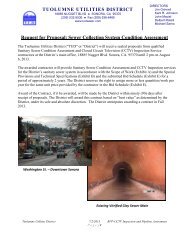Historic Resource Evaluation Project - Tuolumne Utilities District
Historic Resource Evaluation Project - Tuolumne Utilities District
Historic Resource Evaluation Project - Tuolumne Utilities District
Create successful ePaper yourself
Turn your PDF publications into a flip-book with our unique Google optimized e-Paper software.
in three months. The dimensions of the race were three feet in width at bottom; three feet<br />
in depth, with a slope at the sides of one foot to each foot in depth. The fluming was<br />
eight feet wide and two and one-half foot in depth (Lang 1882:122, 123).<br />
As early as April 2, 1853, it was noted that the large canal would be speedily opened,<br />
with water let in from a dam on Sullivan’s Creek and soon to be let in higher at or from<br />
Sugar Pine, providing great benefits to the miners (Sonora Herald, April 2, 1853).<br />
The biggest problem, however, and the one that ultimately proved insurmountable, was<br />
the low volume of water to be found in the North Fork <strong>Tuolumne</strong>, which was insufficient<br />
to supply the ditch all year round. An expedition had set out, however, to survey the<br />
ground and inquire into the practicality of turning the water of the Middle Fork into the<br />
North Fork, so as to increase the supply. Nonetheless, there was believed to be enough<br />
water from the North Fork to supply the ditch for nine months of the year. The<br />
correspondent noted, however, that “the race was often sneered at as being altogether too<br />
large for the purposes aimed at” (Lang 1882:122-123).<br />
By 1853 it was noted that with an abundant supply of water from the ditches of the THA,<br />
the first extended use of sluice boxes forming a continuous flume, often several hundred<br />
feet in length, of the Campo Seco Ditch Company and Messrs. Johnson & Cary came into<br />
vogue. The work proved comparatively easy and the diggings were more extensively<br />
worked than ever before. The growth of Algerine Camp was particularly indebted to the<br />
THA ditch which opened in May of 1853, abandoning the camp at Curtisville when water<br />
ran out (Lang 1882:127-128).<br />
By the following year all was not well, as the THA sold their system of flumes, ditches,<br />
and reservoirs to the <strong>Tuolumne</strong> River Water Company and ceased to exist. Their name,<br />
however, remained on the ditch system, suggesting that the water was still being used for<br />
hydraulicking, and that, perhaps, was operated by some members of the original<br />
company.<br />
The Republican Water Company (RWC), which took water from Curtis Creek, and the<br />
THA and their stockholders sold their ditches in 1854 to the <strong>Tuolumne</strong> River Water<br />
Company (TRWC) (Deed Book 2:807, 808, 809, 810, 811, 812, 813), incorporated April<br />
14, 1853. The TRWC was incorporated for the purposes of carrying, conducting, and<br />
conveying water to different places in <strong>Tuolumne</strong> for mining, mechanical, manufacturing,<br />
and agricultural purposes by means of canals, flumes, and aqueducts and other structures.<br />
Conducting business in Sonora, its officers were Henry W. Williams, Henry Charles, and<br />
Calvin Park (Articles of Incorporation No. 20; Claims Book 1-7:68).<br />
On March 5, 1857, the TRWC system, along with the Algerine Ditch, Kincaid Flat Ditch,<br />
Union Water Ditch, Montezuma Ditch, and other properties owned by the TRWC, was<br />
deeded by Sheriff James M. Smart to San Francisco financier Jonas Gilman Clark, as a<br />
result of a judgment against the company in the Third Judicial Court and the San<br />
Francisco Court. The properties of the TRWC were first sold at auction on September 3,<br />
1856, to Charles E.P. Wood (a San Francisco attorney), who assigned it to Clark on<br />
Foothill <strong>Resource</strong>s, Ltd. 3.18 TUD Ditch Sustainability <strong>Project</strong><br />
Francis Heritage, LLC<br />
<strong>Historic</strong> <strong>Resource</strong> <strong>Evaluation</strong> Report




